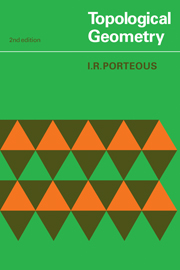Book contents
- Frontmatter
- Contents
- FOREWORD
- CHAPTER 0 GUIDE
- CHAPTER 1 MAPS
- CHAPTER 2 REAL AND COMPLEX NUMBERS
- CHAPTER 3 LINEAR SPACES
- CHAPTER 4 AFFINE SPACES
- CHAPTER 5 QUOTIENT STRUCTURES
- CHAPTER 6 FINITE-DIMENSIONAL SPACES
- CHAPTER 7 DETERMINANTS
- CHAPTER 8 DIRECT SUM
- CHAPTER 9 ORTHOGONAL SPACES
- CHAPTER 10 QUATERNIONS
- CHAPTER 11 CORRELATIONS
- CHAPTER 12 QUADRIC GRASSMANNIANS
- CHAPTER 13 CLIFFORD ALGEBRAS
- CHAPTER 14 THE CAYLEY ALGEBRA
- CHAPTER 15 NORMED LINEAR SPACES
- CHAPTER 16 TOPOLOGICAL SPACES
- CHAPTER 17 TOPOLOGICAL GROUPS AND MANIFOLDS
- CHAPTER 18 AFFINE APPROXIMATION
- CHAPTER 19 THE INVERSE FUNCTION THEOREM
- CHAPTER 20 SMOOTH MANIFOLDS
- CHAPTER 21 TRIALITY
- BIBLIOGRAPHY
- LIST OF SYMBOLS
- INDEX
- Frontmatter
- Contents
- FOREWORD
- CHAPTER 0 GUIDE
- CHAPTER 1 MAPS
- CHAPTER 2 REAL AND COMPLEX NUMBERS
- CHAPTER 3 LINEAR SPACES
- CHAPTER 4 AFFINE SPACES
- CHAPTER 5 QUOTIENT STRUCTURES
- CHAPTER 6 FINITE-DIMENSIONAL SPACES
- CHAPTER 7 DETERMINANTS
- CHAPTER 8 DIRECT SUM
- CHAPTER 9 ORTHOGONAL SPACES
- CHAPTER 10 QUATERNIONS
- CHAPTER 11 CORRELATIONS
- CHAPTER 12 QUADRIC GRASSMANNIANS
- CHAPTER 13 CLIFFORD ALGEBRAS
- CHAPTER 14 THE CAYLEY ALGEBRA
- CHAPTER 15 NORMED LINEAR SPACES
- CHAPTER 16 TOPOLOGICAL SPACES
- CHAPTER 17 TOPOLOGICAL GROUPS AND MANIFOLDS
- CHAPTER 18 AFFINE APPROXIMATION
- CHAPTER 19 THE INVERSE FUNCTION THEOREM
- CHAPTER 20 SMOOTH MANIFOLDS
- CHAPTER 21 TRIALITY
- BIBLIOGRAPHY
- LIST OF SYMBOLS
- INDEX
Summary
The language of sets and maps is basic to any presentation of mathematics. Unfortunately, in many elementary school books sets are discussed at length while maps are introduced clumsily, if at all, at a rather late stage in the story. In this chapter, by contrast, maps are introduced as early as possible. Also, by way of a change, more prominence than is usual is given to the von Neumann construction of the set of natural numbers.
Most of the material is standard. Non-standard notations include f⊢ and f⊢, to denote the forward and backward maps of subsets induced by a map f, and X! to denote the set (and in Chapter 2 the group) of permutations of a set X. The notation ω for the set of natural numbers is that used in and in. An alternative notation in common use is N.
Membership
Membership of a set is denoted by the symbol ∈, to be read as an abbreviation for ‘belongs to’ or ‘belonging to’ according to its grammatical context. The phrase ‘x is a member of X’ is denoted by x ∈ X. The phrase ‘x is not a member of X’ is denoted by x ∉ X. A member of a set is also said to be an element or a point of the set. Sets X and Y are equal, X = Y, if, and only if, each element of X is an element of Y and each element of Y is an element of X.
Information
- Type
- Chapter
- Information
- Topological Geometry , pp. 4 - 25Publisher: Cambridge University PressPrint publication year: 1981
